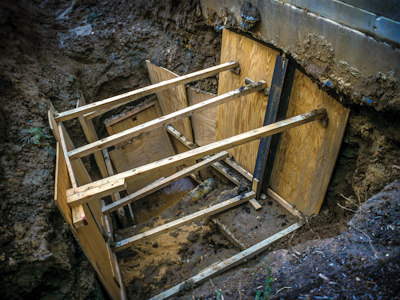
Interested in Safety?
Get Safety articles, news and videos right in your inbox! Sign up now.
Safety + Get AlertsEditor’s Note: This is the first installment of a two-part article that discusses 14 things you and your work crews must plan for to greatly reduce — and even eliminate — the dangers around trenches and excavations. Here we provide the first six items. In Part 2, we will present the remaining eight steps on the list.
The General Requirements Section of OSHA’s Subpart P provides a number of common-sense steps to help ensure worker safety. As with any OSHA Standard or other safety procedure, it is important to always remember that these are the minimum requirements to ensure safe job sites.
1. Surface encumbrances
To ensure their stability and integrity, they need to be removed or supported while an excavation is open. Examples include rocks, trees, telephone and utility poles, fire hydrants, etc.
2. Underground installations
Examples include gas, electrical, water, sewer lines, etc. They must be:
- Located and marked before beginning work. Property owners and/or utility companies should be notified at least 24 hours prior to digging, unless a longer time is required by local law. Some states require 72 hours advance notice. Most other states require 48 hours notice.
- Protected, supported or removed while the trench is open
Most states have so-called “811 One-Call” laws. Simply dial 811 to contact the One-Call Center in your state.
3. Access and egress
These are fancy words for entering and exiting a trench. The requirements are:
- In trenches that are 4 feet or more in depth, provide a means of access and egress
- Spacing between ladders, stairs or ramps should not be more than 50 feet
- No worker should have to travel more than 25 feet laterally to reach a means of egress (exit)
- Ladders must be secured and extend 36 inches above the landing
In addition, it is important to use wood or fiberglass ladders where there is a possibility of electric shock. Many utility companies and contractors always use wood or fiberglass ladders to ensure there is never a problem.
A “Competent Person” must design all structural ramps used solely by employees. Further, a Competent Person qualified in structural design must design all structural ramps used for equipment. Usually this person will be a registered professional engineer.
Finally, the components used in structural ramps must be connected, be of uniform thickness, be constructed so that cleats and other connectors do not create a tripping hazard, and if ramps are used instead of steps they must be provided with cleats or other surface treatments to prevent slipping.
4. Exposure to vehicular traffic
Employees must be protected from being struck by motor vehicles. Also, employees must be provided with — and must wear — warning vests or other highly visible garments when exposed to traffic. Generally, employees are considered “exposed” when they are within the right-of-way. Signs, signals, barricades or flagmen may be required.
5. Exposure to falling loads
The law is simple. The objective is to protect employees from being struck by falling objects:
- Employees are not permitted underneath raised loads
- Employees are required to stand away from equipment that is being loaded or unloaded
- Equipment operators or truck drivers may stay in equipment if it is properly equipped with a cab shield or adequate canopy
6. Warning system for mobile equipment
Preventing vehicles from falling or backing into a trench can be accomplished by providing:
- Barricades
- Hand or mechanical signals
- Stop logs
- Grading away from the excavation
Equipment with an obstructed view is required to have working backup alarms, or observers must be assigned when backing up. Suggestion: Caution your employees not to be complacent around backup alarms. On some projects, there are so many backup alarms, employees may ignore them.
Check back next week for Part 2, when we will continue with the remaining eight potential dangers to which you must give attention.
 About the author
About the author
David Dow is chair of the training committee of the North American Excavation Shoring Association (NAXSA) and co‑founder and vice president of TrenchSafety and Supply Inc. NAXSA was formed in July 2014 with the core purpose of promoting the safe and effective use of excavation shoring equipment and practices. The ultimate goal of the association is zero deaths and injuries in the excavation construction industry. For more information, visit www.naxsa.com.
This article and all photos are copyright 2015 TrenchSafety and Supply Inc. Used with permission of TrenchSafety and Supply Inc. for this specific article.








